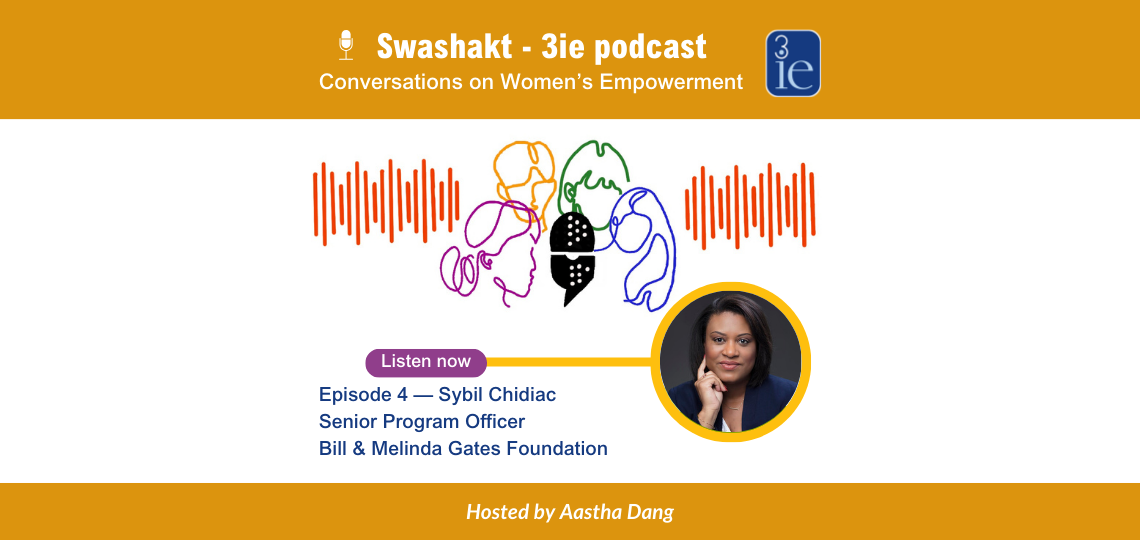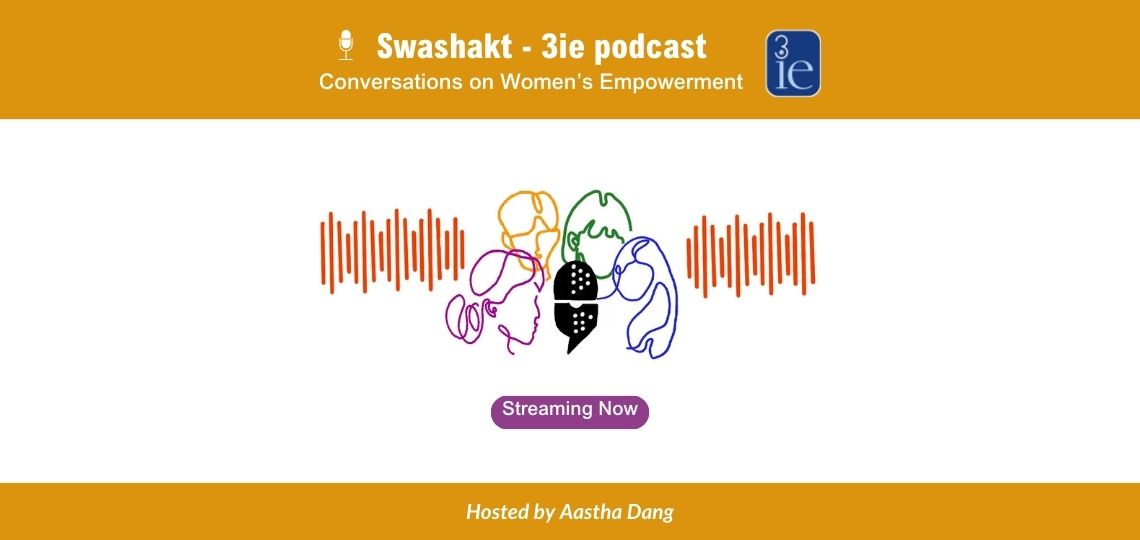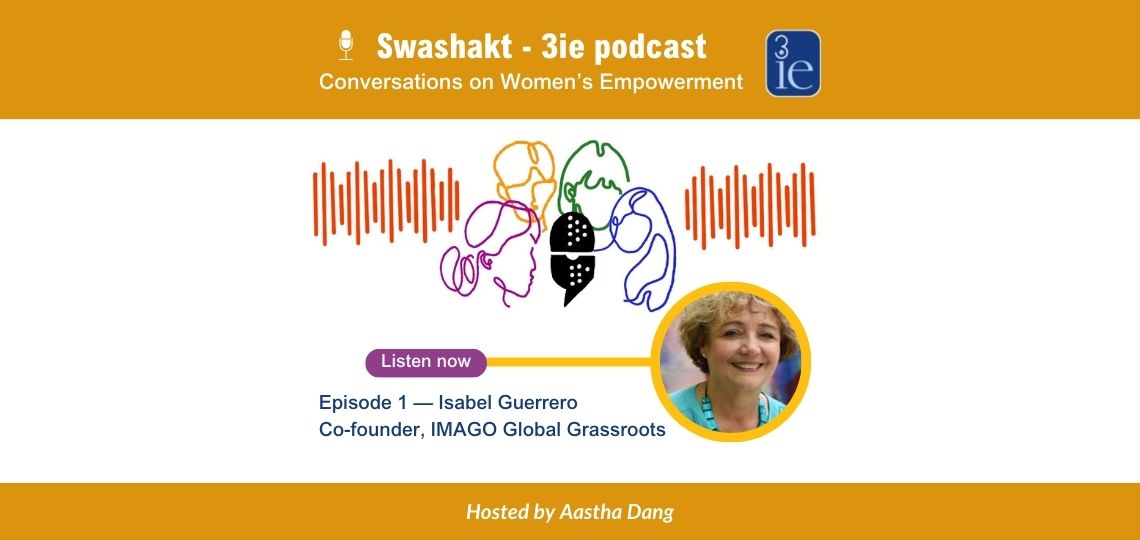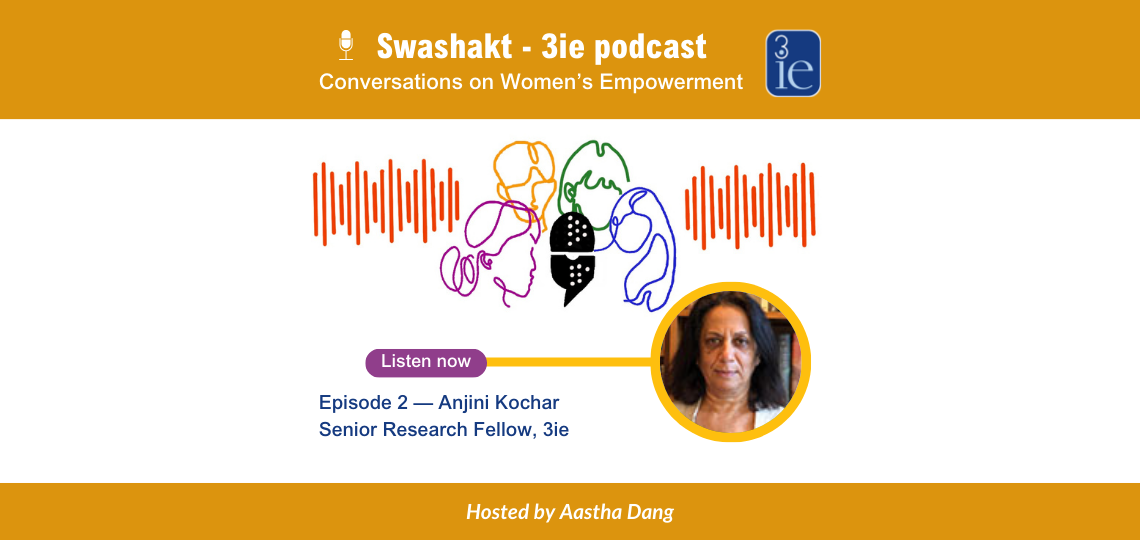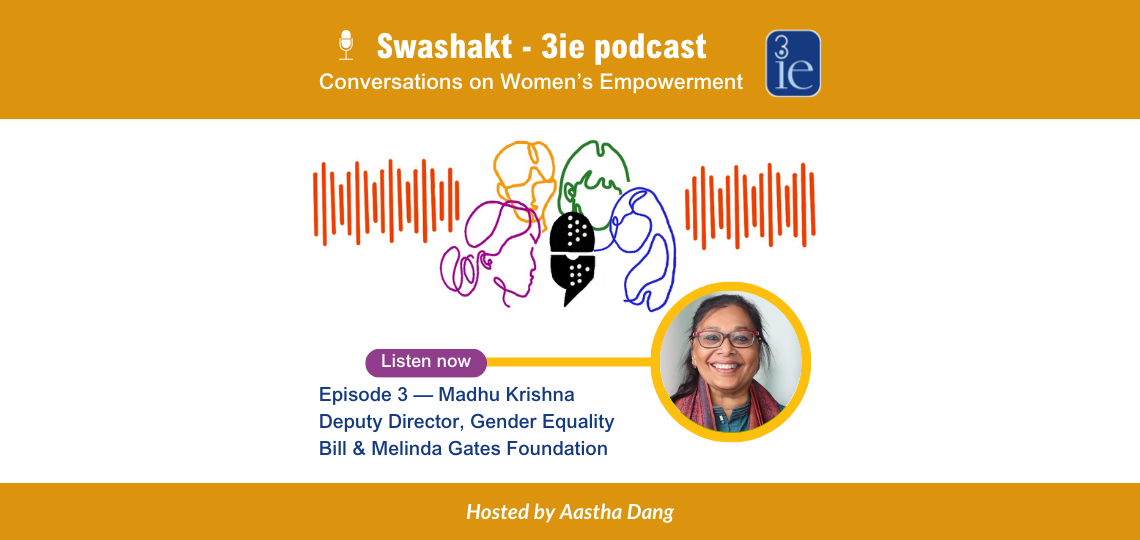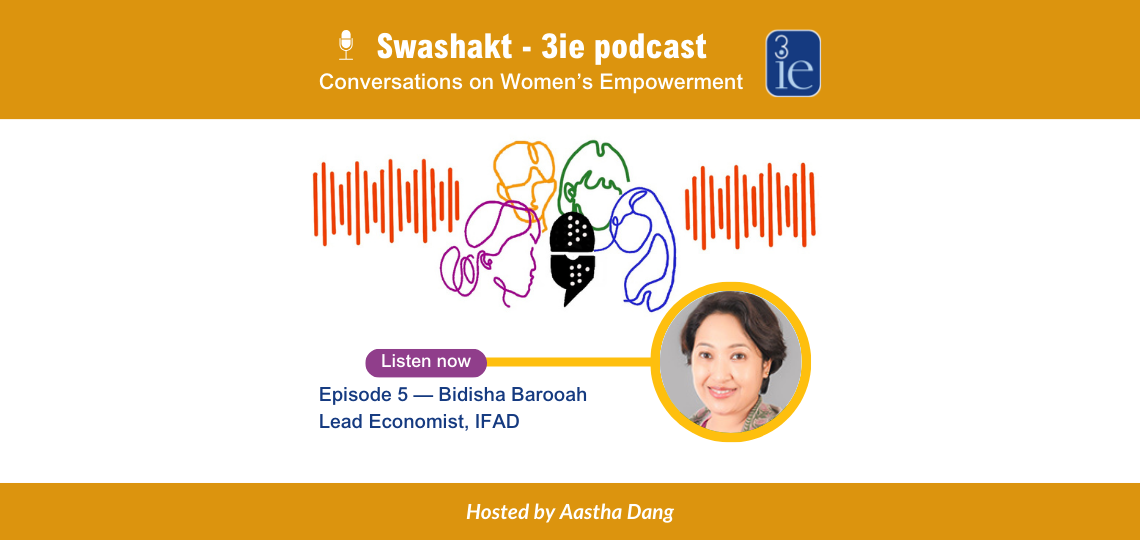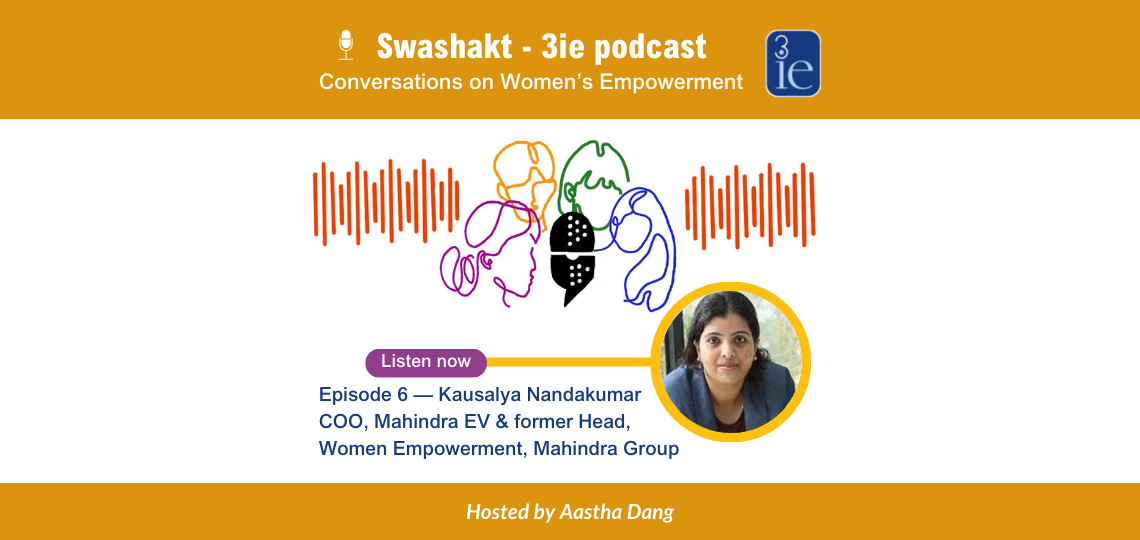Overcoming barriers with information and knowledge – with Sybil Chidiac
About the episode
In the fourth episode of the Swashakt podcast series, 3ie evaluation specialist Aastha Dang speaks to Sybil Chidiac, Senior Program Manager at the Bill & Melinda Gates Foundation. Chidiac is a key lead for the Foundation's Women's Economic Empowerment (WEE) initiatives in Africa.
She elaborates on the key role of information, knowledge and know-how in overcoming the stumbling blocks such as lack of access to digital literacy and market linkages, and for unlocking true women’s potential.
This podcast series has been produced by the International Initiative for Impact Evaluation (3ie) and is inspired by our Swashakt evidence program and our Rural India Livelihoods Project. The views expressed are those of the speakers and do not necessarily reflect positions or policies of 3ie.
Host: Aastha Dang
Production lead: Kirthi V Rao, Tanvi
Production support: Annie Vincent, Durgadas Menon, Shailendra
Disclaimer: The podcast has been edited for clarity.
[Intro]
Aastha: The world is not on track to achieving Sustainable Development Goal #5 on gender equality and women's empowerment. Where have we reached and how far do we need to go? While data can throw light on this question, there is no substitute for the wisdom of practitioners. Join us for this podcast series as we try to understand empowerment better and explore the pathways towards economic empowerment, in particular self-empowerment for women who are part of collectives in low- and middle-income countries. We are talking to a series of women whose training and experience can act like beacons on this journey. I am Aastha Dang, Evaluation Specialist at 3ie. In this episode, I'm speaking to Sybil Chidiac, who's a Senior Program Officer with the Bill and Melinda Gates Foundation. Hi Sybil! Thank you so much for joining us for this podcast series and we are excited to get started. I would like to jump right into this. And my first question is, whom do you see as an empowered woman?
[Slow transition ]
Sybil: Thank you, Aastha. It's a pleasure to be here with you today. I think that's a very timely question and one that's important. I do think an empowered woman is one who's able to believe in herself, able to make decisions about her own life and people around her. She has the ability to make her own money, source of income, and decisions. She also has the ability to decide how best to spend that money and income without being forced. She is someone who's able to access and use what we call productive resources. So access to skills, access to credit, access to other financial service products. And really, she has that ability to make a contribution to her own needs as well as her household's needs. She has that ability to question discriminatory norms that negatively affect her and other women. She has that ability to defend herself and those she cares for. She has that ability to adapt, having her own voice being listened to by others, respected by others, including her spouse, family members, community members. And really able to meet her own and family household needs. And I do think it's all of those things and it's some of those things.
I also think that empowerment is a slow transition. It's not like a woman wakes up empowered after accessing productive resources. And it's not that a woman feels empowered every day either. Really what I see is that women, because of norms and barriers, have to choose what battles they fight. And being educated and armed with knowledge, knowing when and how to advocate for what's right, or what she believes in, is empowerment as well in my opinion.[Questioning global yardstick for local empowerment]
Aastha: Thanks. So well, this was so beautifully worded. You actually connected the entire ambit of various domains of empowerment to the everyday experience of women and how they can feel empowered and dis-empowered. My next question to you is what are some common beliefs about women's empowerment that you would question?
Sybil: Definitely, I think I have some. I don't think you can empower a woman by working only with the woman. A lot of programming that we see today is directed to women and the common question that comes out when entering a community is what about the men and the boys? I often say that you can have programs that target a woman and her spouse. She can have voice, decision-making authority and contributes in an equitable manner. But the moment that she walks out the door and the moment her spouse walks out the house door, they will be expected to follow the societal behaviors and practices. So as long as we ignore the community, the relations and structures in which women and men interact, we will never truly advance women's economic empowerment in a sustainable manner.So some of the empowerment measures as well are other areas where I do think that we need to question. Some of these measures that are being applied such as psychometrics, using depression, anxiety as measures of empowerment. And I understand that this could be context-specific and easily caused by different factors. But using a global yardstick to measure local empowerment, I think, is a belief that we have to question.
[Stories of transformation]
Aastha: You have been working in the sphere of women empowerment for so long, So what is it that excites you about promoting women's empowerment?
Sybil: I hear countless stories of a quiet, reserved woman who becomes the mayor or is elected into municipal council or becomes a local parliamentarian. So, it's that story of transformation: the transformation of communities, markets. I hear electrification of a whole village that was conceived by a women's group. The construction of a new house or putting a more quality roof on top of the house, sending children to school. I see the stories of inter-generational change, of household change, accessing better food, joint decision making. Those are the stories of transformation that truly excite me.
And watching that slow transformation of a woman from her inner self to really gaining confidence, believing in who she is, having that ability to decide on what is best for her and really influence and make and earn her own money. Seeing that inner as well as physical transformation. I think that's the most exciting aspect when I meet women and I learn about what women's economic empowerment truly looks like for them.[Groups of women – a solid platform]
Aastha: I think my next question to you would be then, how do you think mobilizing women into groups helps to empower them, you know, strengthen their voice or agency? Something that you just spoke about is so important to women's empowerment.
Sybil: When women mobilize into savings groups or women's collectives, it really helps them to move out of their restricted home environment. It builds their social economic capacity through pooled resources, sharing of knowledge, learning from each other, through experiences as well as building social capital that inherently builds their resilience to overcome shocks. And many of the communities that we work in social networks are the key to communities.
Social networks are what powers the lives of people. It's not individualistic societies, it is community-led, socially-led societies. So it enables a woman to social network and really start to hone in and build confidence as well as leadership skills. And it starts very small within groups and sometimes goes beyond the groups. As I mentioned earlier, we see women elected into official capacity, working in government, but also being asked to lead community development operations. So really groups provide a solid platform for women to pool resources, access information, advocate for services. And those services include financial services, access to market, health, which is also a very important aspect. And really advocate for their own rights and advocate for the training that they need.
It also provides them the opportunity to start testing out what it means to start engaging in entrepreneurial activities and how to do it in a collective manner. You know starting to build their products and build that confidence to engage and start trading with the market. So it really also helps to build capacity to address negative norms around their entrepreneurial activities, around any type of violence that may occur, but also around their financial health and their ability to contribute as well as benefit from household expenses as well as different areas where they can now contribute.
So I really see these groups as sort of a stepping stone for women to start to engage and practice behaviors that will enable them to go further in their livelihood activities, but also in their citizen engagement.[Lack of information, capacity and access]
Aastha: Thanks, Sybil! You just gave us so many, you know, positives about women collectivization. But according to you, are there any stumbling blocks to collectives empowering women?
Sybil: I definitely think there's a lot of stumbling blocks and I think one of them that I've touched on is around the gender and social norms. I think that's a big aspect of where women experience barriers to their mobility, their ability to speak up, their ability to do certain things in their communities and beyond. So I think the gendered social norms are a big stumbling block. We all recognize that in order to truly help unlock women, there are some negative, harmful norms that have to be addressed and really overcome. And it's not just overcome by sort of getting certain women over the wall, but it's really tearing down that wall. I do think another huge stumbling block is women's lack of access to information.
That information is in the form of just basic information that helps them make decisions about their livelihoods, about certain goods and products that they are selling or buying. And also it's about just knowledge, you know, knowledge on how to operate. Businesses operate even as small, as nano, enterprises.
Just having that knowledge of how to keep your financial books separate from your personal finances and then how do you expand a business, How do you look for new products, new opportunities? How do you actually conduct a market feasibility assessment? And then how do you even look to finding new buyers, new markets to which you can sell your product or good to. So I think some of that information broadly captures information, knowledge and then also capacity building. Know how.
I think another stumbling block for women is around low productivity and that's very much directly linked to lack of access to information, but also lack of access to productive capital in order to invest in ideas and livelihood opportunities that they have. And part of that is around land. For women who find themselves in agriculture, just having access to land as a productive resource is a major hurdle they face. Or they may have access to land, but it's restrictive access. So that's a major impediment given that women largely find themselves in the rural areas in agriculture.
There's also this aspect of control. You know who actually has control? Control of assets, productive assets, and who can use those assets to help further any type of livelihood activity. So really, control and use of resources is another huge stumbling block for women. There's also restrictive policies and laws. There's also, you know, going back to norms, there could be policies that are in place but are not enforced. Or the norms of any community will enforce the traditional behaviors and not really be aligned with the laws that are in place. I do think that there are fragmented ecosystems with a lack of adequate coordination. That also is a huge impediment for women, the lack of digital literacy and even access to smartphones as well as feature phones that have access to information or the ability to use it as a platform and access different types of applications that can help either acquire new knowledge or connect to the market is a huge impediment. I also think that there aren't clear aggregation models that work to help amplify women's voices. So that's another area I think where it's a stumbling block for women where they do belong in SACCOs (Savings and credit coops) across the African continent, but the female participation rates are very low. They're not the majority most times in those SACCOs and they don't occupy the leadership positions.[Not designed for women]
And I really think there's limited and uncoordinated resources that are being channelled directly to women that take in a gender perspective of how to reach women. So designed for women. We often hear that if a product is designed for everyone, it's not designed for women, it's actually designed for men. And I do think in looking at collectives, in particular, there's a lack of general gender empowerment skilling that is embedded into collectives. And now I understand this is a new kind of wave of gender empowerment that's being embedded into savings groups, into SHGs in India. But it wasn't so, you know, 5-10 years ago. So there's this new wave of actually building in capacity building for gender.
And I always go back to the financial aspects as well, which as we as we see through savings groups across Africa: the internal savings has truly been a powerful tool for women. But it also limits the individual woman who is ready to go further. There are certain limits to what she can access in a group.
There are, you know, the funds are rotated and shared. Not equally, but they are shared amongst all group members who have the same needs and the resources are finite. They're not, you know, a big pool of resources that women can draw from according to their needs. It's really about what they have saved and contributed and how they can divide that up and allow for women within the group to access. Loans so that they can invest in their livelihood activities. So I do think the financial assets that are kept in a group is also a limit. It definitely is something that the women have pulled together themselves. They have been able to access financial services at their doorstep essentially, but there's a limit to what those financial services provide. Unless they are able to be linked to a formal financial institution and access more products as they grow in their livelihoods and as they grow in their activities.[Opportunities that enable women to transition]
Aastha: Sybil you raised some very crucial points that are challenges in this process of collectivization. From your own experience, if you can provide some example from the ground, you know, of some of the challenges that you stated I think that will be that will just be very interesting to know more about.
Sybil: Yes, I think one of the challenges that we are seeing today is as markets are advancing, women do not have the skills that they need to engage in those markets. In many African markets, they don't have the ability to engage in e-commerce platforms. So move from that informal business that they are leading into a more formal structure. It is about skilling, it is about the know-how in terms of registration, in terms of products qualification, if I can call it, making sure their product is certified and meets certain requirements in order to be sold on a commerce platform, a digital commerce platform.
I think that's a major impediment for women. They have ideas, they have products that people value and enjoy. But they, you know, they must stay in the informal market just because of lack of access to skills. But also, you know, something that I had mentioned before, the lack of women being connected and being thought of as a player in markets and therefore designing solutions that will bring women into sort of like an e-commerce, you know, for example, an e-commerce space. So I think there is something about capacity building, ensuring that women have the skills, the knowledge that they need in order to make those transitions. So it's not always about you know growing from a micro enterprise into a small enterprise. Sometimes it's just about accessing different markets and being able to sell your goods or offer services in a different way because of childcare constraints, because of mobility constraints. We know that a lot of these social norms and these hurdles still exist for women.
So there are some opportunities I really think that digital provides but we're not seeing enough traction. We're not seeing enough movement to really support women's integration into those opportunities. Same thing with public procurement opportunities. Sometimes the law exists, there is a quota, there is an affirmative action that says 30% of all contracts must be given to women-owned and women-led enterprises. Yet where's the data on that?
How are we supporting women to actually access those procurement and compete in those procurement opportunities. So I do think it's the skilling, it's the know-how, but really if we're trying to be intentional about lifting economies and ensuring that women are part of that economic growth for any nation, then there's different strategies that have to be employed in order to really attract, retain and help women advance in those opportunities.
In those opportunities and that's where you know it's, I don't know if it's really an example that I'm giving you, but this is where I've seen a challenge on the ground really, and in terms of what is policy versus practice. So yeah, maybe it is an example of what needs to be done and what isn't working right which we can focus our attention on to ensure that women have those opportunities as they are transitioning, as they are growing their businesses or even just keeping their businesses afloat.[Transformation through savings groups unparalleled]
Aastha: I want to ask you what are some women interventions that you feel like we know enough about, but are yet to be seriously implemented.
Sybil: Well from the African continent perspective, I really think first and foremost – the use of savings groups as a platform to reach women. In a cost-effective manner is isn't. It is an intervention that is well known: groups have existed for decades across Africa. There are traditional groups. It's mainly for social cohesion that women come together for some of those same reasons that they are still together today: to consolidate their voice and have the ability to have that safe space, but also that ability to support each other and advocate for what they need. So I do think savings groups, especially those that are, you know, over 40 percent, 60% of female in membership is a women's empowerment intervention that we know enough about, but it's not seriously being implemented with a range of partners from public to private sector.
There are some challenges of course: the private sector not poised to form and fund the delivery of the formation of these groups. The public sector, on the other hand, has an opportunity in developing these platforms and really seeing these platforms as a way to drive convergence across a number of public sector goals as well as programs.
Many African governments have on their agenda to drive and strengthen greater private sector participation. So if government invests in these platforms as a mechanism to reach women, I really feel that that is an intervention that provides an aggregated group of women together so that it starts to make sense for the businesses, for the private sector to actually reach women in that manner. So I will always be a strong advocate for savings groups. I see it as one of the strongest women's empowerment interventions, economic empowerment, health empowerment, agricultural empowerment. In my lifetime I've seen over 500 groups across 20 countries. I have been to those communities visited, sat with them through a meeting, talked with them. And I've witnessed the transformation of women through those groups and it's unparalleled. It meets them where they are and it gives them the capacity and the wherewithal to aspire and plan, while also demonstrating to others the power of a woman.
Now the digital sub wallet project that was implemented in Uganda with Care International and Post Bank and MTN provided women with access to a financial product that responded to the way that they need and use money. It really combined that with financial literacy, household dialogues to address the norms around women setting goals, making choices about the money that they're putting aside. And really help them build their financial autonomy.
I do think that women business mentoring and coaching using women mentors that's another women's empowerment intervention that we know about but aren't seriously implemented. That could be a cost issue: how do you provide tailored specialized support to women by another woman or by a mentor, that can become costly. But I think if embedded really can start to deliver on building a woman's capacity and enabling her to really have some key unlocks in her enterprise.
I also think that we know that women's credit repayment rates are higher and stronger than men yet product offerings designed for women and offered to women are rare. We know women repay. We have there's evidence all around about how women are repaying at 99%, you know, very strong levels of repayment rates. Yet financial institutions, formal financial institutions, aren't designing more products for women, knowing that they are a more credible and reliable, trustworthy client.[Engaging women as serious clients]
Aastha: Five hundred groups across 20 countries. Wow. I mean that sounds so amazing. And I think you gave very key recommendations over there, especially with your example of the digital sub-wallet in Uganda. I would like to come to my last question to you now, which is what are some key unknowns about women's empowerment for which more evidence is needed?
Sybil: So I was recently in Uganda and I sat through a presentation that was done on a gender validation study. And I think for the first time in my career, the validation study was actually validating the measurement indicators that were being used to measure gender empowerment and determining whether they were valid for the Ugandan context. So I was totally blown away by that. I think measurement frameworks that are reflective of the way women define empowerment from their own perspective, but also what does empowerment or women's empowerment mean in that specific country or even that geography?
We know that there are some regional nuances that can occur within a country. So you know, not having some imposed definition of empowerment, but really looking at measurement frameworks that are defined from women's perspectives and understanding what a woman's empowerment, her journey, her path and how that cuts across their transition. Women are constantly in transition, humans are constantly in transition. But as women are accessing skills, as they're accessing resources what does that journey for that woman look like as she is transitioning, you know, from a child, from an adolescent, from a young woman to a young mother to a woman that's married, etcetera. So what does empowerment mean to each of these women? And looking at the measurement frameworks that are closely aligned to their own perspective and designing frameworks that are reflective of their of their stages in life and their own perspective. And then earlier I talked about working on the ecosystem and in essence more evidence needs to be brought forward on upskilling and training. Also norms or the institutions which women need to access for their livelihoods to flourish but are, you know, currently a barrier, I think need more evidence to change the incentives and the game of engaging women as serious clients.
And I do think, you know for decades I've worked in women's economic empowerment and really focusing on financial service provision, skills provision. But time and time again it comes down to: I have all these skills, I have the resources, but what about the markets? Help me access the markets, help me diversify, help me grow. So not only can I access this market, but as I'm engaging in this market, there's going to be new things I'd want to add on or I'm going to need to figure out. How do I actually grow my business? When do I start hiring people? When do I start outsourcing certain things? So having more evidence around what really works to engage women into markets, even if you know, after you're working with that woman, giving this, giving them the skills that they need to be successful. Putting them in contact with financial service providers, I mean this is the ideal world. If products and services are available, then how do we ensure that women are actually accessing markets, new markets, diversifying their market connections and being able to truly grow and I think we need more evidence around that as well.
Aastha: Thanks. Sybil. This was so great. I was actually making notes in between because I think I learned a lot by talking to you and it was, it was really wonderful. Thank you so much.
